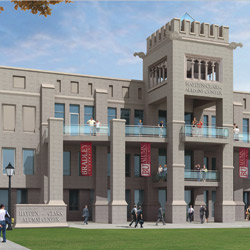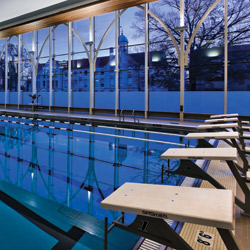Funding a Bright Future

Students of all ages in the Greater Peoria Area will soon benefit from the completion of a number of important construction initiatives, ranging from critical renovations and building modernizations to the addition of major new campus facilities. The new and improved buildings will support academic programming while also boosting student recruiting at the college and university level.
Bradley University, Illinois Central College and Peoria School District 150—supported by the Public Building Commission of Peoria—have all embarked upon long-planned construction programs that will enhance area campuses as well as several aging schools. The three institutions have moved forward on their building plans thanks to a diverse array of funding mechanisms that are helping to address much-needed capital projects.
Campaign for a Bradley Renaissance
Bradley University’s “Campaign for a Bradley Renaissance” will support both new construction and renovations on the campus, which dates to 1897. Now well underway, the campaign has reached nearly $126 million of its $150 million goal, with a new recreation center and parking deck constructed so far.
The Markin Family Student Recreation Center, which opened in October 2008, is a $30 million facility that offers students nearly four times more space for exercise, fitness and student service programs than the university’s previous recreation building. The building was funded in part by an $8 million gift from David Markin, a 1953 Bradley graduate.
“Our alumni feel a strong affinity to the university,” says Bradley University President Joanne K. Glasser. “They understand that the success of the next generation of students is vital to our community and beyond. Their generosity has been instrumental in helping to realize the vision of the ‘Bradley Renaissance.’”
The capital program’s ambitious plans also include transforming Westlake Hall, one of the original campus buildings, into a modern academic facility; and the new Hayden-Clark Alumni Center, which will include an alumni library, conference center, offices and a ballroom. Alumni Jerry and Marilyn Keller Hayden and Robert Clark, along with his wife Kathleen, donated a combined $5 million toward the project. Work has begun on Westlake Hall, the Hayden-Clark Alumni Center, a new Athletic Performance Center—which will include a 4,500-seat arena—and the Puterbaugh Men’s Basketball Practice Facility. Westlake and the Hayden-Clark Alumni Center will be LEED-certified gold and silver, respectively.
 Looking ahead, Glasser points to the planned Engineering and Business Convergence Center as the final “Renaissance” project—a 327,000-square-foot facility that will integrate the university’s engineering and business programs. While acknowledging the strong impact that alumni contributions have made to the campaign, she also notes the importance of support from another major stakeholder—the business community.
Looking ahead, Glasser points to the planned Engineering and Business Convergence Center as the final “Renaissance” project—a 327,000-square-foot facility that will integrate the university’s engineering and business programs. While acknowledging the strong impact that alumni contributions have made to the campaign, she also notes the importance of support from another major stakeholder—the business community.
“Peoria businesses understand that the region’s future success will be based in large part on the preparation of tomorrow’s workforce. Companies like Caterpillar, which has generously donated millions of dollars toward our campaign, have clearly demonstrated their support for high-caliber education in the Peoria community.”
Green and Growing
In East Peoria, Illinois Central College is also looking to create a significant new asset for students and the community. Construction is underway on the “CougarPlex,” one of the largest building projects ever undertaken on the campus. The $16 million complex, which is being funded through a combination of general obligation bonds and student fees, consists of a 54,000-square-foot addition to the existing gymnasium and a 9,000-square-foot renovation.
The CougarPlex will substantially increase the college’s fitness, sports and recreation space, and will incorporate extensive sustainable design concepts such as a green roof and other energy-conserving measures. Students, employees and the general public will all have access to the new facility, which will help the college address its growing enrollment and intercollegiate sports programs, as well as new programs for health and wellness.
A Long-Planned Modernization
Many of the city’s younger students will also see major improvements to their facilities in the coming months. The Public Building Commission of Peoria, using municipal bonds, is overseeing the funding, design and construction of several building projects for Peoria School District 150, including additions and renovations at Richwoods High School, Lindbergh Middle School, Northmoor Edison Middle School and Keller Primary School.
Established in 1958, the Public Building Commission has been instrumental in managing construction initiatives for the district. The commission maintains strict criteria for the funding and administration of capital projects, and brings expert skills in project management to the process, including project scoping, selection of design consultants and contractors, and incorporating long-term provisions and funding for operations and maintenance.
“Currently, we have projects valued at $62 million under construction,” says Jim Thornton, executive director of the Public Building Commission of Peoria. “We’re also looking at a new project that is about $27 million. These projects will support the district’s academic programs much more effectively—some of the existing buildings date to the 19th century.”
Thornton adds that the current capital program will not raise the local tax rate, and notes the commission’s role in ensuring that taxpayers receive maximum value in the new and renovated buildings. “We try to keep the design and construction process local,” he says, “and we monitor it closely. We’ve built and repaired many of Peoria School District 150’s buildings—we want to make sure they are all worthy projects and that taxpayers are getting the most for their money.” iBi
Don White is a principal with the architecture/engineering firm of PSA-Dewberry.

